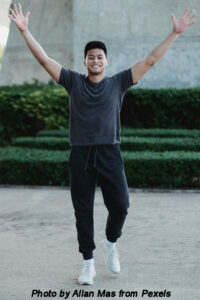 In an earlier post, I talked about how mindfulness practice directs us to connect with the body and bodily sensations, NOT transcending it. When we are awake in the body, we live life in the here and now – not reflecting on the in the past, not anticipating the future, and not lost in thought or imagination. The body confers several other benefits as well.
In an earlier post, I talked about how mindfulness practice directs us to connect with the body and bodily sensations, NOT transcending it. When we are awake in the body, we live life in the here and now – not reflecting on the in the past, not anticipating the future, and not lost in thought or imagination. The body confers several other benefits as well.
The body can help steady the mind. My go-to resource is mindfulness of the breath using the body’s natural rhythm. Admittedly, it can be easy to get distracted after two or three breaths. I take advantage of several practices to sustain focus:
- Naming the length of the breath – e.g., “breathing in short, breathing out short, or breathing in long, breathing out long. Not forcing the breath to be short or long, but simply being an attentive observer.
- Adding words to inhalations and exhalations – e.g., thinking PEACE while breathing in and EASE while breathing out.
- Simply counting the breaths.
Sound can serve as an alternate anchor – noticing what’s in the foreground, what’s in the background, perhaps giving names to them. Noticing what arises and fades away. In all cases simply observing and not getting caught in thoughts of what might be causing the sounds, or what they mean.
The sense of touch can also serve as an anchor – the touch points with the floor, chair, body parts against each other – and naming the sensations (warmth, coolness, hard, soft, lightness, heaviness, moisture, dryness). I regularly sense the touch points in the car seat and my hands on the wheel when I find myself distracted while driving. It’s a quick way to drop out of being lost in thought and focus on what I’m doing.
The body can be a place of refuge. When caught in a rising tide of worry, a flood of frustration or irritation, or hailstorm of anger, connecting to the body can have a profoundly calming effect. To break out of spinning in my head, I stop and notice the touch points of the body with my surroundings and then glance around the room and whisper the name of things around the space I’m in. It’s grounding and gives me a chance to experience the ever-powerful PAUSE.
The body can be a kind of barometer. When sensitive to the body, it provides a wealth of information. Standing at a fork in the road: Do I take (or keep) this job? Should I tackle this project? Should I invest in this relationship? The body provides a more truthful response than the mind as it’s not weighed down by shoulds, peer pressure, guilt, etc. Also, checking in with the body and asking: Does this possibility make me feel relaxed, open, interested? Or is my heart in my throat, my stomach churning, my temperature rising?
The body can be a teacher. It provides an ongoing lesson in impermanence. Those of us with a few years under our belts know that bodies do not stay the same. But when we pay attention in the moment, we even notice that sensations in the body change. Itching comes and goes. Cravings rise and fall. Pain changes in nature if we are patient enough to sit with it and observe it.
Physical sensations also provide an object lesson in making the distinction between direct experience and the add-ons we bring to it. For example, we may feel tension in our backs and think to ourselves, “I’m always stressed out. I’ll never relax. I’m too uptight!” In reality, we are just feeling tension in our backs. We don’t need to pile on absolutes or character assessments.
Beyond focusing on the breath, sounds, or touch points, what are ways that we can experience mindfulness of the body?
We can be attentive to our posture, finding positions that give us comfort, ease, and stability. Our postures can be lying down, sitting, standing, walking, running. And we can be mindful of transitions from one posture to another.
We can be mindful in our daily activities. Showering. Dressing. Fixing a meal. Eating. Washing dishes. Doing chores. We can ask: Am I putting any unnecessary tension into this activity? Am I rushing to get through it, as if to say: “This moment doesn’t matter; let me get it out of the way so I can get to my real life!” Or, can I welcome every activity as part of the here and now?
We can experience the body as being part of nature, sharing in the ancient elements of earth, water, fire, and air. Tissues, bones, teeth. Blood, saliva. Temperature. Breath. As we read in Ecclesiastes 3:19-20:
“For what happens to the children of man and what happens to the beasts is the same; as one dies, so dies the other. They all have the same breath, and man has no advantage over the beasts, for all is vanity. All go to one place. All are from the dust, and to dust all return.”
We are all connected. A part of the great circle of life.